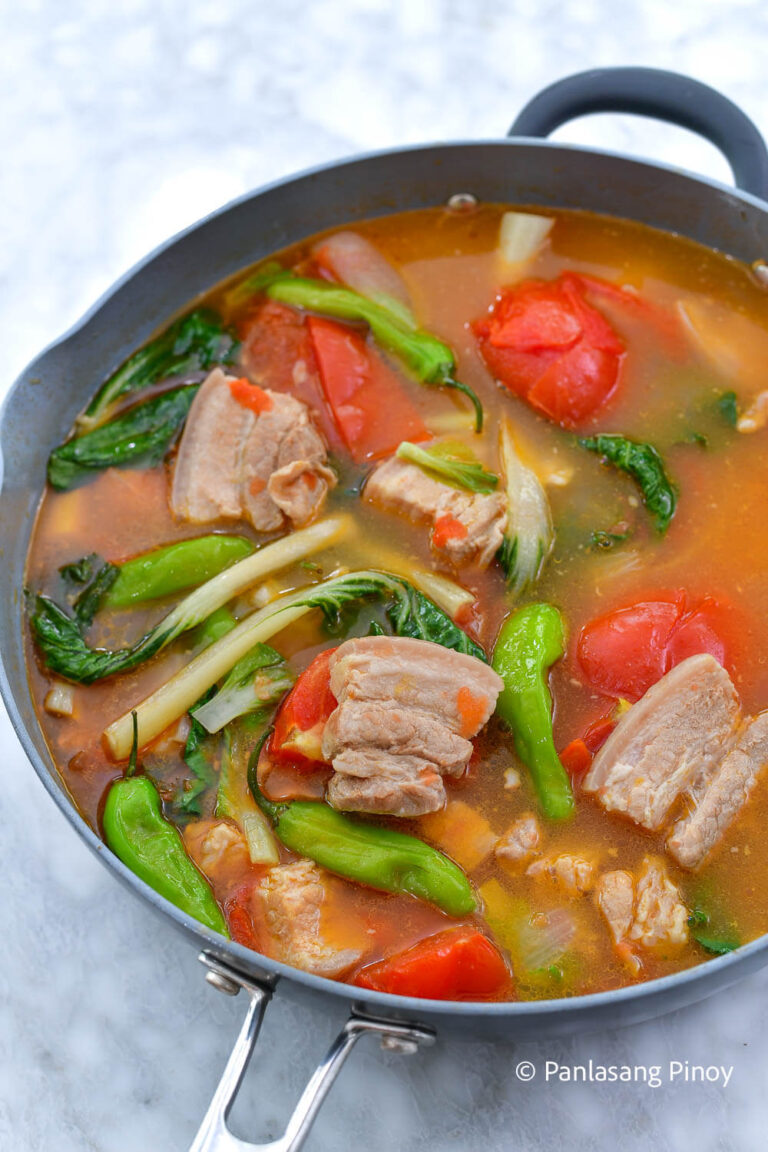Kinamatisang Baboy is a traditional Filipino dish known for its flavorful pork simmered in a tomato-based sauce.
This post may contain affiliate links. Please read our disclosure policy.
The name “Kinamatisang Baboy” combines two Filipino words: “kinamatisan,” derived from “kamatis,” meaning “tomato,” and “baboy,” which means “pork.” The term “kinamatisan” implies a dish cooked with tomatoes. Thus, the name reflects the dish’s main ingredients and cooking method. This dish is popular in Filipino households, often served with rice, and is perfect for a rainy day, whether for lunch or dinner. To try making Kinamatisang Baboy yourself, follow this recipe that highlights its rich, tomato-based sauce and tender pork.

How To Cook Kinamatisang Baboy
Heating Oil and Sautéing Aromatics
Start by heating 3 tablespoons of cooking oil in a pot over medium heat. Once the oil is hot, add 3 cloves of crushed and chopped garlic, sautéing until golden brown to release their rich flavor. Next, add 2 thumbs of crushed ginger and 1 wedged onion. Cook for about a minute.
Browning the Pork Belly and Adding Tomatoes
Next, add 2 lbs. of sliced pork belly to the pot. Cook until the pork turns light brown, which enhances its flavor and richness. After the pork has browned, stir in half of the 5 wedged tomatoes. Cook for an additional minute to help break them down.
Simmering the Pork for Tenderness and Flavor Development
Pour in 4 cups of water, bringing the mixture to a boil. Once it reaches a boil, reduce the heat and let it simmer for 45 minutes. This slow cooking process tenderizes the pork and allows the flavors to meld beautifully, resulting in a savory broth for your Kinamatisang Baboy.
After the pork has simmered, add the remaining tomatoes, 3 long green peppers, and 2 bunches of baby bok choy. Cover the pot and cook for 3 minutes. This brief cooking time ensures the vegetables remain crunchy and vibrant, balancing the rich flavors of the pork.
do the final seasoning with maggi magic sarap
Finally, stir in 8 grams of Maggi Magic Sarap, cooking for an additional minute to fully incorporate the seasoning. This step deepens the flavor profile of your Kinamatisang Baboy. Once ready, transfer the dish to a serving bowl and enjoy it warm with rice. Share this delightful meal with family and friends for a satisfying experience!


Kinamatisang Baboy Ingredients
This recipe features pork and tomatoes (kamatis) as its main ingredients, with a strong emphasis on the tomato flavor. Therefore, select ripe, plump tomatoes rather than green ones for the best results. Here are the ingredients of this delicious recipe.
- 2 lbs. pork belly, sliced – Fatty and flavorful cut of pork, sliced to enhance tenderness and richness in the dish.
- 2 bunches baby bok choy – Mild and tender leafy green that adds a crunchy texture and fresh flavor.
- 2 thumbs ginger, crushed – Crushed to release its aromatic oils, providing a warm, spicy note and depth to our Kinamatisang Baboy.
- 3 cloves garlic, crushed and chopped – Crushed and chopped to release essential oils, contributing a pungent, savory flavor.
- 1 onion, wedged – Wedged to infuse sweetness and complexity as it caramelizes during cooking.
- 5 tomatoes, wedged – Wedged to create a rich, tangy base and add a slight acidity to balance the pork’s richness. Make sure to pick plump tomatoes for our recipe.
- 3 long green peppers – Added for a subtle heat and extra layer of flavor.
- 4 cups water – Used to create the broth for simmering and tenderizing the pork.
- 3 tablespoons cooking oil – For sautéing, it helps to brown the garlic, ginger, and pork.
- 8 grams Maggi Magic Sarap – A seasoning mix that adds a savory, umami taste to deepen the overall flavor of Kinamatisang Baboy.


Sinigang Na Baboy Vs. Kinamatisang Baboy
Sinigang na Baboy and Kinamatisang Baboy are two popular Filipino dishes featuring pork but differ significantly in flavor and preparation. Sinigang na Baboy is a sour soup where pork is simmered with various vegetables and a souring agent, typically tamarind, to achieve a tangy taste. On the other hand, Kinamatisang Baboy is a tomato-based stew where pork is cooked in a rich tomato sauce with vegetables. The focus of Kinamatisang Baboy is on a savory, slightly sweet tomato flavor, and it is thicker and less acidic compared to Sinigang na Baboy.
How Sour Flavors Shape Filipino Food
Sour flavors are a big part of Filipino cooking. Such recipes include the all-time favorite of many, Sinigang, as well as Sinampalukang Manok and Sweet and Sour Tilapia. Ingredients like tamarind, calamansi (a small citrus fruit), and green mangoes are common because the tropical climate is perfect for growing them. These sour tastes balance the rich flavors of meats and the sweetness in dishes. Spanish colonization also brought new cooking methods and flavors, which mixed with local traditions. This blend created the unique sour taste that is now a key feature of Filipino cuisine.


Did you make this? If you snap a photo, please be sure tag us on Instagram at @panlasangpinoy or hashtag #panlasangpinoy so we can see your creations!


Kinamatisang Baboy
Pork stew cooked with tomatoes, ginger, garlic, and vegetables.
Instructions
Heat oil in a cooking pot. Sauté the garlic until it starts to brown.
3 tablespoons cooking oil, 3 cloves garlic
Add ginger and onion. Continue cooking for 1 minute.
2 thumbs ginger, 1 onion
Add the pork belly. Sauté until the color turns light brown (around 2 minutes).
2 lbs. pork belly
Add half of the tomatoes. Cook for 1 minute.
5 tomatoes
Pour the water and let it boil. Simmer for 45 minutes.
4 cups water
Add remaining tomatoes, long green pepper, and bok choy. Cover and cook for 3 minutes.
5 tomatoes, 3 long green peppers, 2 bunches baby bok choy
Put-in the Maggi Magic Chicken Cube. Stir. Cook for 1 minute.
8 grams Maggi Magic Sarap
Transfer to a serving bowl. Serve with warm rice.
Share and enjoy!
Notes
Best Tomatoes for Kinamatisang Baboy
For Kinamatisang Baboy, using ripe Roma tomatoes is a good choice. Roma tomatoes are firm and have fewer seeds, which helps them cook down into a rich sauce without becoming too watery. Their slightly sweet and tangy flavor complements the pork well. You can also use other types of tomatoes, such as on-the-vine or plum tomatoes, which have a similar texture and flavor. These tomatoes will provide a good balance of taste and texture, making the Kinamatisang Baboy both delicious and well-textured.Nutritional Benefits Of Kinamatisang Baboy
Pork provides a good source of protein, essential for muscle growth and repair. Tomatoes, the main flavoring component, are rich in vitamins A and C, as well as antioxidants like lycopene, which can help protect against certain diseases. Baby bok choy, another healthy addition of this Kinamatisang Baboy recipe, brings extra health benefits. It is low in calories but packed with vitamins A, C, and K, plus minerals like calcium and potassium. The fiber in bok choy helps with digestion and supports good health overall. This combination makes this Kinamatisang Baboy recipe not only a flavorful meal but also a nutritious option for maintaining overall health.Nutrition Information
Calories: 1319kcal (66%) Carbohydrates: 12g (4%) Protein: 23g (46%) Fat: 131g (202%) Saturated Fat: 45g (225%) Polyunsaturated Fat: 16g Monounsaturated Fat: 63g Trans Fat: 0.04g Cholesterol: 163mg (54%) Sodium: 206mg (9%) Potassium: 835mg (24%) Fiber: 3g (12%) Sugar: 6g (7%) Vitamin A: 1326IU (27%) Vitamin C: 29mg (35%) Calcium: 45mg (5%) Iron: 2mg (11%)
Source link



